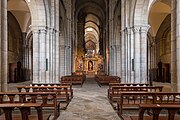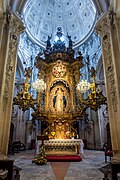Lugo Cathedral
Saint Mary's Cathedral (Galician: Catedral de Santa María), better known as Lugo Cathedral, is a Roman Catholic church and basilica in Lugo, Galicia, north-western Spain. The cathedral was erected in the early 12th century in a Romanesque style, with Gothic, Baroque and Neoclassical elements.
History
A church existed in the site from 755. In 1129 Bishop Peter III commissioned a new edifice in the latest architectural style from Raimundo, a local architect and builder. This Romanesque structure was completed in 1273.
Later renovations and restorations added elements in other styles, such as the Renaissance retablo at the high altar. It was destroyed in the 1755 Lisbon earthquake and fragments of it are housed in the church.
The cathedral received from the Pope the privilege to permanently expose the Holy Sacrament.
Structure
The cathedral has a Latin Cross structure, with a length of 85 m. It has a nave, covered by a barrel vault, and two aisles, with an ambulatory and five apse chapels. The triforium features triple ogival mullioned windows. The apse houses a calvary sculpture from an unknown date.
The façade is a Renaissance design by Julián Sánchez Bort [es] inspired by a plan proposed by Ventura Rodríguez for the Cathedral of Pamplona. Its construction was finished in the late 19th century, with the completion of the two side towers.
The northern entrance's narthex is in Gothic style, dating to 1510-1530. Internally showing a starred vault, it is formed by three archivolts with a lintel showing Christ Pantocrator and with a pinjante (glove-shaped decorative pendant) that features a depiction of the Last Supper.
To the right of the entrance is the Gothic Torre Vella (bell tower), surmounted by a Renaissance top floor finished by Gaspar de Arce in 1580. The sacristy (1678) and the cloister (1714) are in the Baroque style, as is the central chapel of the triforium (1726). The chapel of St. Froilán is in Renaissance style, dating to the 17th century. Notable is the choir, built by Francisco de Moure (early 17th century).
-
 View with the bell tower and the Gothic-style rear, featuring buttresses.
View with the bell tower and the Gothic-style rear, featuring buttresses. -
 Cloister
Cloister -
 Main Nave
Main Nave -
 Ambulatory
Ambulatory -
 Chapel of the Virgin of the Big Eyes
Chapel of the Virgin of the Big Eyes
References
- Cegarra, Basilio (1992). Guia da arte de Galicia. Vigo.
{{cite book}}: CS1 maint: location missing publisher (link)
- v
- t
- e
- 669bis-001: Primitive Way
- 669bis-002: Northern Way
- 669bis-003: French Way
- 669bis-004: Liébana Way
- 669bis-005: Cathedral of San Salvador and Holy chamber (Oviedo)
- 669bis-006: Church and Monastery of San Salvador (Salas)
- 669bis-007: Lugo Cathedral
- 669bis-008: Roman walls of Lugo
- 669bis-009: Collegiate Church of Ziortza (Ziortza-Bolibar)
- 669bis-010: Cathedral of Saint James apostle (Bilbao)
- 669bis-011: Church of Santa María de la Asunción (Castro Urdiales)
- 669bis-012: Collegiate church and cloister of St Juliana (Santillana del Mar)
- 669bis-013: Church of San Salvador de Priesca (Villaviciosa)
- 669bis-014: Church of Santa María de Soto de Luiña (Cudillero)
- 669bis-015: Mondoñedo Cathedral
- 669bis-016: Sobrado dos Monxes Abbey
- 669bis-017: Tunnel of San Adrian
- 669bis-018: Cathedral of Santa María de Vitoria (Vitoria-Gasteiz)
- 669bis-019: Briñas bridge over the Ebro river (Haro)
- 669bis-020: Monastery of Santo Toribio de Liébana (Camaleño)
















